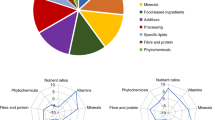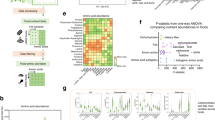Abstract
Objectives:
To determine the content of glutamine in major food proteins.
Subjects/Methods:
We used a validated 131-food item food frequency questionnaire (FFQ) to identify the foods that contributed the most to protein intake among 70 356 women in the Nurses’ Health Study (NHS, 1984). The content of glutamine and other amino acids in foods was calculated based on protein fractions generated from gene sequencing methods (Swiss Institute of Bioinformatics) and compared with data from conventional (USDA) and modified biochemical (Khun) methods. Pearson correlation coefficients were used to compare the participants’ dietary intakes of amino acids by sequencing and USDA methods.
Results:
The glutamine content varied from 0.01 to to 9.49 g/100 g of food and contributed from 1 to to 33% of total protein for all FFQ foods with protein. When comparing the sequencing and Kuhn's methods, the proportion of glutamine in meat was 4.8 vs 4.4%. Among NHS participants, mean glutamine intake was 6.84 (s.d.=2.19) g/day and correlation coefficients for amino acid between intakes assessed by sequencing and USDA methods ranged from 0.94 to 0.99 for absolute intake, −0.08 to 0.90 after adjusting for 100 g of protein, and 0.88 to 0.99 after adjusting for 1000 kcal. The between-person coefficient of variation of energy-adjusted intake of glutamine was 16%.
Conclusions:
These data suggest that (1) glutamine content can be estimated from gene sequencing methods and (2) there is a reasonably wide variation in energy-adjusted glutamine intake, allowing for exploration of glutamine consumption and disease.
This is a preview of subscription content, access via your institution
Access options
Subscribe to this journal
Receive 12 print issues and online access
$259.00 per year
only $21.58 per issue
Buy this article
- Purchase on Springer Link
- Instant access to full article PDF
Prices may be subject to local taxes which are calculated during checkout
Similar content being viewed by others
References
Bachmair A, Finley D, Varshavsky A (1986). In vivo half-life of a protein is a function of its amino-terminal residue. Science 234, 179–186.
Bairoch A, Apweiler R (2000). SWISS-PROT protein sequence database and its supplement TrEMBL in 2000. Nucleic Acid Res 28, 45–48.
Baxter JH, Phillips RR, Dowlati L, Johns PW (2004). Glutamine in commercial liquid nutritional products. J Agric Food Chem 52, 4963–4968.
Borel MJ, Williams PE, Jabbour K, Levenhagen D, Kaiser E, Flakoll PJ (1998). Parenteral glutamine infusion alters insulin-mediated glucose metabolism. JPEN 22, 280–285.
Composition of Foods Loose-leaf Agriculture Handbook No 8 Series (1976–1992). Agricultural Research Service. United States Department of Agriculture (USDA). US Government Printing Office. Washington DC.
Friedman M (1996). Nutrition. In: Nakai S, Modler W (eds). Food Proteins: Properties and Characterization, Chapter 6, Wiley-VCH: New York. pp 281–298.
Kuhn KS, Schumann K, Stehle P, Darmaun D, Furst P (1999). Determination of glutamine in muscle protein facilitates accurate assessment of proteolysis and de novo synthesis-derived endogenous glutamine production. Am J Clin Nutr 70, 484–489.
Kuhn KS, Stehle P, Furst P (1996). Quantitative analysis of glutamine in peptides and proteins. J Agric Food Chem 44, 1808–1811.
Lacey JM, Wilmore DW (1990). Is glutamine a conditionally essential amino acid? Nutr Rev 48, 297–309.
Opara EC, Tevrizian A, Feinglos MN, Surwit RS (1996). L-glutamine supplementation of a high fat diet reduces body weight and attenuates hyperglycemia and hyperinsulinemia in C57BL/6J mice. J Nutr 126, 273–279.
Osuga DT, Feeney RE (1977). Egg proteins. In: Whitaker JR, Tannenbaum SR (eds). Food Proteins. AVI Pub. Co., Inc.: Westport, CT. pp 209–221.
Joint FAO/WHO Expert Consultation (1989). Protein quality evaluation: report. Bethesda, MD, USA, 4–8 December. Accessed on 1 December 2008 at: www.fao.org/docrep/U5900t/u5900t07.htm.
Reeds PJ, Garlick PJ (2003). Protein and amino acid requirements and the composition of complementary foods. J Nutr 133 (Suppl 9), 2953–2961.
Sarwar G (1997). The protein digestibility-corrected amino acid score method overestimates quality of proteins containing antinutritional factors and of poorly digestible proteins supplemented with limiting amino acids in rats. J Nutr 127, 758–764.
Schegg KM, Denslow ND, Andersen TT, Bao YA, Cohen SA, Mahrenholz AM et al. (1997). Quantitation and identification of proteins by amino acid analysis. In: Marshak DR (ed). Techniques in Protein Chemistry VIII. Academic Press: San Diego. pp 207–216. For more information, please see http://www.abrf.org/index.cfm/group.show/AminoAcidAnalysis.19.htm accessed on 1 December 2008.
Schloerb PR, Cook LT, Hall TJ (2002). Digestive release of glutamine from enteral wheat protein hydrolysate. Am J Clin Nutr 75 (Suppl 2), 403 (abstract).
Swails WS, Bell SJ, Borlase BC, Forse RA, Blackburn GL (1992). Glutamine content of whole proteins: implications for enteral formulas. Nutr Clin Pract 7, 77–80. Erratum in: Nutr Clin Pract 1992;7(3):133–134.
US Department of Agriculture, Agricultural Research Service (2006). USDA. Nutrient Database for Standard Reference, Release 1–16. Nutrient Data Laboratory. For more information, please see http://www.ars.usda.gov/Aboutus/docs.htm?docid=9418 and www.nal.usda.gov/fnic/foodcomp/Data/SR16-1/sr16_doc.pdfaccessed on 1 December 2008.
Willett W, Sampson L, Stampfer MJ, Rosner B, Bain C, Witschi J et al. (1985). Reproducibility and validity of a semi quantitative food frequency questionnaire. Am J Epidemiol 122, 51–65.
Wu ZC, Chijang CC, Lau BH, Hwang B, Sugawara M, Idota T (2000). Crude protein content and amino acid composition in Taiwanese human milk. J Nutr Sci Vitaminol (Tokyo) 46, 246–251.
Acknowledgements
We are indebted to the Nurses continuous participation in the Nurses’ Health study. We particularly thank the Swiss Institute of Technology for providing free access to their Web site, the Ross laboratory for teaching CL how to navigate on the Expasy Web site, and Martin Van Denburgh for programming support. Supported by 5T32DK007703-07 and K23 DK082732.
Author information
Authors and Affiliations
Corresponding author
Rights and permissions
About this article
Cite this article
Lenders, C., Liu, S., Wilmore, D. et al. Evaluation of a novel food composition database that includes glutamine and other amino acids derived from gene sequencing data. Eur J Clin Nutr 63, 1433–1439 (2009). https://doi.org/10.1038/ejcn.2009.110
Received:
Revised:
Accepted:
Published:
Issue Date:
DOI: https://doi.org/10.1038/ejcn.2009.110
Keywords
This article is cited by
-
Dietary amino acids and risk of stroke subtypes: a prospective analysis of 356,000 participants in seven European countries
European Journal of Nutrition (2024)
-
The use of biomarkers associated with leaky gut as a diagnostic tool for early intervention in autism spectrum disorder: a systematic review
Gut Pathogens (2021)
-
Glutamine and Asparagine in Nutritional Products
Food Analytical Methods (2021)
-
Plasma concentrations and intakes of amino acids in male meat-eaters, fish-eaters, vegetarians and vegans: a cross-sectional analysis in the EPIC-Oxford cohort
European Journal of Clinical Nutrition (2016)
-
Milk consumption during pregnancy increases birth weight, a risk factor for the development of diseases of civilization
Journal of Translational Medicine (2015)



